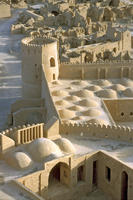You are in: Middle East -> Iran -> Bam and its Cultural... , and traditional search or Image Gallery will yield results of this site only
Bam and its Cultural Landscape
| Site number: | 1208 |
|
| Type of site: | Cultural | |
| Date: | 6th-4th cent.BC | |
| Date of Inscription: | 2004, 2007 | |
| Location: | Middle East, Iran (Islamic Republic of), Kerman Province, Bam District | |
Up to 75 images are shown here. Click on each for more details or on Image Gallery for more images.
Six official UN languages:
Arabic,
Chinese,
English,
French,
Russian,
Spanish
Other languages: Danish, Dutch, Esperanto, Farsi, German, Italian, Japanese, Malay, Norwegian-bokmål, Polish, Portuguese, Swedish, Low German
Other languages: Danish, Dutch, Esperanto, Farsi, German, Italian, Japanese, Malay, Norwegian-bokmål, Polish, Portuguese, Swedish, Low German
| Description: | Bam is located on the southern edge of the Iranian high plateau, within a desert environment. Bam’s origins date back to the Achaemenid period, the 6th to 4th centuries BC. The site reached its zenith from the 7th to 11th centuries, as it sat at the crossroads of significant trade routes and was notorious for its silk and cotton garment production. The qanāts, the underground irrigation canals, were at the core of existence for living in this oasis; some of the earliest evidence of these in Iran has survived. The Citadel of Bam (Arg-e Bam) is the best illustration of a fortified medieval town that was built in local technique of mud layering (Chineh). --WHMNet paraphrase from the description at WHC Site, where additional information is available. For 360 degree imaging of this site, click here. | |
| Bam is a city in Kerman Province of Iran. The city is the center of Bam County. The modern Iranian city of Bam surrounds the Bam citadel. Before the 2003 earthquake the official population count of the city was of around 90,000. There are various opinions about the date and reasons for the foundation of the citadel. Some people believe that Bam city was founded during the Parthian empire, a very powerful Persian empire, that ruled from 250 BCE to 226 CE. Economically and commercially, Bam occupied a very important place in the region and was famed for its textiles and clothes. --Wikipedia. Text is available under the Creative Commons Attribution-ShareAlike License. For 360 degree imaging of this site, click here. | ||
| Source: | http://whc.unesco.org/en/list/1208 | |
| Source2: | http://whc.unesco.org/en/list/1208/video | |
| Reference: | 1. UNESCO World Heritage Center, Site Page. | |







































